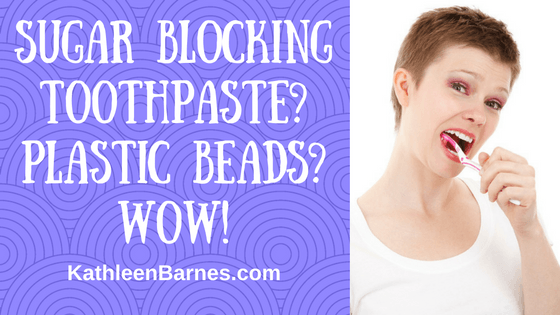Over the holidays, I caught a commercial for Crest Sugar Shield, toothpaste. Really? Does this mean my grandkids and I can chow down on truffles, chocolate bars, cakes and pies and never suffer any negative results?
Not exactly, but that’s exactly what Crest wants us to believe.
There are two big problems here.
- I’m guessing Crest really means there is some substance that is blocking sugar from contact with teeth. Even assuming this is true and blocking sugar from your teeth may or may not stop cavities, the commercial opens the door to the idea that using Crest makes it fine to chow down on sugar. Sugar Shield absolutely won’t do anything at all to stop the poisonous effects of sugar on the rest of your body. I’ve written lots about the problems of sugar.
https://kathleenbarnes.com/sugar-kills/
https://kathleenbarnes.com/sugar-is-killing-us-and-our-kids-too/
https://kathleenbarnes.com/more-reasons-why-sugar-is-deadly-even-if-youre-skinny/
https://kathleenbarnes.com/sugar-death-trap/ - What the heck are they using to “block sugar”? On its website, Crest proudly announces that it’s the “biggest breakthrough in toothpaste since fluoride.” Really?? Oh, thanks—we know fluoride is an industrial waste that has severely negative effects on thyroid and bone health. What the heck is in Sugar Shield? More on that coming right up.
So I did a little Googling and came up with some disturbing info about what’s in Crest’s Sugar Shield. First of all, you may or may not be familiar with the little blue-ish green speckles in this toothpaste. They are polyethylene. Plastic. The most common type of plastic in the world. It’s just like the plastic used in plastic bags, toys, bottles, garbage cans, etc. It is not biodegradable. It just breaks down into smaller and smaller particles until the human eye can no longer detect it, but it’s still there.
Thanks, Proctor and Gamble, manufacturers of Crest, for a double whammy: First, they tell us that their product will make it OK to eat sugar and, worse yet, they put a toxic chemical in toothpaste that can have serious health consequences. Bear with me.
There’s one important difference between your toothpaste and your garbage can: You’re not supposed to eat the garbage can or your water bottle or plastic bags. Most of us wouldn’t.
Toothpaste, by its very nature, ends up in the human digestive system, whether accidentally or not. It also ends up on your teeth and in the small spaces between teeth and gums where it can stay for extended periods of time.
That brings up the next problem: A fascinating blog entry from a dental hygienist explains how she and her fellow hygienists have seen these blue plastic beads embedded in the spaces around gums virtually every day. Just in case you’re incredulous about the presence of plastic in toothpaste, here’s proof from Proctor and Gamble, the manufacturers of Crest, printed right on the box. If you’re like most of us, you probably throw away the box that contains the toothpaste ingredients. Here’s proof, thanks to the National Library of Medicine.
There’s some good news: New Congressional legislation (if it stands) outlaws these “microbeads” by the summer of 2017, not because they are harmful to human health, but because they are too small to pass through filters in water treatment plants, so they end up in waterways and act as sponges for toxins, including pesticides, heavy metals and endocrine disrupting phthalates.
My question: If microbeads act as sponges for toxins in the external environment, won’t they do the same in the “internal” environment of the human body? And wouldn’t this be a particularly serious problem if those tiny plastic beads stayed in contact with permeable mucous membranes, like the gums, for extended periods of time?
This is all quite disturbing.
Of course, we could all just be quiet and wait for the new laws to go into effect that will ban microbeads in virtually all Crest toothpaste and some facial washes, or we can stand up and say this is not acceptable. It’s not at all acceptable.
Here are some action steps you can take now:
You can return Crest toothpaste wherever you bought it on the grounds it contains a toxic ingredient (actually more than one, but we’ll go into the dangers of fluoride another time). Ask the retailer to tell Proctor and Gamble why you returned the product.
Lodge a consumer complaint with Crest at (800) 959-6586.
Send an e-mail to Crest with your complaint.
Tell your friends.
It’s through constant vigilance, consumer awareness and pressure that we can make these products safer.
Finally, thanks to Congress for passing this legislation. Let’s hope it sticks!








So what is this special ingredient that makes the sugar sheild. I can’t find it anywhere. My family and I use colgate total and have for years which contains triclosan which I know is not good for us but it’s the only toothpaste that keeps out teeth clean. Just wondering what kind of poison crest is using.